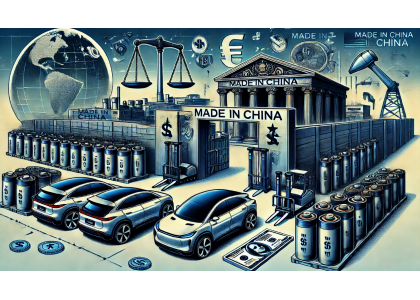LIFTCHEM-UV Curing Raw Materials, Pharmaceutical Intermediates

5
September 13, 2024, the Office of the US Trade Representative (USTR) confirmed hiked tariffs on Chinese imports, including EVs. Per the USTR, those increased duties include a 100% tariff on Chinese-built EVs, a 50% tariff on solar cells, and 25% on steel, aluminum, EV batteries, and other critical minerals.
The tariffs above will go into effect on September 27, but there are more to follow. A determination by the USTR posted on Friday also stated that the US would impose a 50% duty on Chinese semiconductors, divided into two new categories – polysilicon used in solar panels and silicon wafers. Both those tariffs are expected to go into effect in 2025.
The USTR did not amend the tariff increase from zero to 25% on lithium-ion batteries, minerals, and components for EV batteries, which will begin this month, as mentioned above. Tariffs on those materials in other Chinese electronics, including laptops and cell phones, will take effect on January 1, 2026.
The announced tariffs for relevant EV product categories include:
Increase in tariff on EVs from 25% to 100% starting in 2024
Increase in tariff on battery parts (non-lithium ion batteries) to 25% in 2024
Increase in tariff on EV lithium ion batteries to 25% in 2024
Increase in tariff on lithium ion non-EV batteries to 25% in 2026
Increase in tariff on natural graphite to 25% in 2026
Increase in tariff on other critical minerals of 25% in 2024
Increase in tariff on permanent magnets of 25% in 2026
Increase in tariff on semiconductors of 50% in 2026

On the non-EV side, the USTR’s determination also includes new tariffs on other Chinese imports, including USTR doubled duties on Chinese face masks, surgical gloves, and syringes.
The increase of tariffs on China's EVs can serve multiple purposes, including domestic political strategies and efforts to counter China's growing influence in the global EV market. The effectiveness and underlying motives can be analyzed from different perspectives:
1. Domestic Political Strategy:
Job Protection and Economic Security: In countries like the United States and those in the European Union, imposing tariffs on Chinese EVs can be framed as a measure to protect domestic industries. By making Chinese imports more expensive, governments aim to encourage consumers to buy locally-produced EVs, thereby supporting domestic manufacturers and preserving jobs.
Political Appeal: Tariffs can be used as a political tool to appeal to certain voter bases, particularly in regions with significant manufacturing sectors. For politicians, taking a tough stance on China can be a way to garner support from constituents who feel threatened by foreign competition, especially in industries like automotive manufacturing.
2. Suppressing China's Influence:
Leveling the Playing Field: China has been a dominant player in the EV market, partly due to government subsidies and other support mechanisms for its EV industry. Tariffs are one way to counter what some countries see as unfair trade practices, making it harder for Chinese companies to undercut prices and flood the market with cheaper products.
Strategic Autonomy: Countries may impose tariffs to reduce dependence on China, especially for strategic industries like EVs and lithium-ion batteries. This move is part of a broader strategy to ensure that critical technologies and industries are not overly reliant on a single foreign power, especially one that is seen as a strategic competitor.
3. Effectiveness of Tariffs:
Mixed Results: The effectiveness of tariffs can vary. While they may protect domestic industries in the short term, they can also lead to higher prices for consumers and potential retaliation from China, leading to trade tensions that may impact other sectors.
Market Dynamics: Tariffs might slow down China's growth in certain markets, but they may also push Chinese companies to innovate further or seek alternative markets. Additionally, they can lead to a global reshuffling of supply chains as countries and companies adapt to the new trade environment.
Long-term Impact: The effectiveness in the long run depends on whether domestic industries can leverage this period of protection to become more competitive on a global scale. If not, tariffs may end up being more of a temporary fix rather than a long-term solution.
4. International Relations:
Geopolitical Tensions: Tariffs on Chinese EVs and batteries can exacerbate tensions between China and the imposing countries, contributing to a broader trade and technology rivalry. This approach can be seen as part of a larger strategy to contain China's economic and technological rise.
In summary, tariffs on China's EVs can be both a political strategy to win domestic support and a tool to address economic and strategic concerns regarding China's growing influence. The effectiveness of this approach varies depending on economic conditions, the adaptability of domestic industries, and the broader geopolitical context.